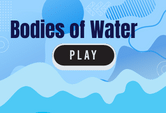Types Of Bodies Of Water Game Quiz Online
Learn about types of bodies of water game quiz online for students in 5th, 6th, 7th, 8th grades. This game features 15 test questions with one correct answer option. Select the correct answer and move to the next question. The different types water bodies include lakes, oceans, rivers, ponds. Each type is distinct; a lake is an enclosed body of water, a river is a linear stretch from source to estuary. An ocean is salty and the largest body of water on Earth. Learn about the different water bodies and their characteristics; through this online quiz.

We know the different types of waters around the world. Whether fresh or saltwater, large or small, these bodies of water have different characteristics and can be divided into three basic types: Oceans, rivers, lakes and ponds. Let us learn more about each of these types and what they have in common.
Lake
Lakes are bodies of water. Smaller bodies of water may be mistaken for lakes. However, they are more like ponds. However, some lakes are much larger than other bodies of water. Whether or not a lake is larger than a body of water depends on the source of its water. A good example of a lake is Lake Kivu, Lake Nyos, Lake Erie, etc.
Pond
Ponds are biodiverse freshwater ecosystems with a variety of uses. They provide water for agriculture and livestock, serve as breeding grounds for many species, and reduce evaporation. Ponds also help prevent excessive growth of algae, control mosquito populations, and serve as huge waste sinks. In the past, ponds were not used as a source of fish. However, with the increasing use of ponds for recreational purposes, a more responsible approach has been developed.
Sea
The oceans and seas of the world are bodies of saltwater. These vast bodies of water lie along the coasts of the continents and are partially surrounded by land. The Mediterranean Sea, the South China Sea, and the Caribbean Sea are the best known seas. The South China Sea contains an abundance of islands and is considered the largest. It is currently a disputed area between Japan, China and the Philippines.
Cove
A bay is a cove that is not completely surrounded by the sea and is usually made of softer rock. They can range from bays to large inlets and are often indistinguishable from larger bodies of water. A bay can also be a small, sheltered area with a narrow entrance.
Epeiric sea
The Epeiric Sea is a shallow ocean covering part of a continental landmass. These waters are usually no deeper than 200 meters. They are the result of an abrupt change in oceanic conditions. These seas are usually warm, but they can also be cold. They were present at the end of the last ice age, when sea levels rose rapidly.
Marsh
A marsh is a body of water that contains a variety of plant and animal species. The ecosystem of a swamp is characterized by the presence of different water depths, resulting in a mosaic of different vegetation zones. This, in turn, leads to a greater diversity of plant and animal species. For marshes with diverse ecosystems, at least fifty percent of the water depth is less than one-half foot, thirty percent is between one-half and three feet, and twenty percent is between three and six feet.
